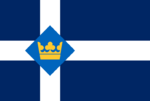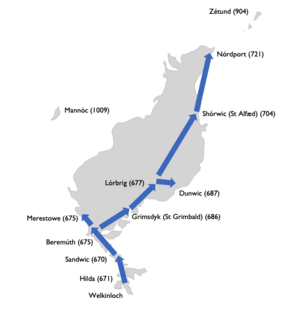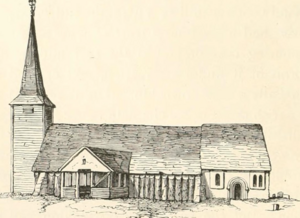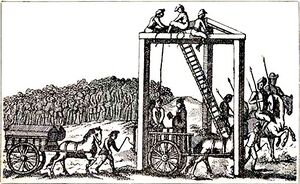Myrcia

|
Kingdom of Myrcia Rícecynig Myrcia (Myrcian) Capital: Dunwic
|
Loading map... |
The Kingdom of Myrcia is an island nation located in north-west Uletha. It is a constitutional monarchy with a bicameral elected legislature. The official language is Myrcian though Ingerish is also widely spoken. It has long relied on the Hesperic Ocean for its wealth, its major industries are oil and gas exploration, fishing and tourism. The capital, and largest city, is Dunwic, the two other Myrcian cities are Nórdport and St Grimbald.
History
| History of Myrcia | |
|---|---|
| The First Kingdom | 675 - 1120 |
| • First Recorded Human Settlement | c. 450 BCE |
| • Wulfric, first Myrcian king | 675 |
| • The Fennel War | 1016 |
| Scandic and Ingerish Rule | 1120 - 1669 |
| • Scandic Invasion | 1120 |
| • Establishment of Scandlaw | 1192 |
| • Ingerish-Scandic War | 1226-1230 |
| The Second Kingdom | 1669 - Present |
| • War of Myrcian Independence | 1669 |
| • Council of Welkinloch | 1701 |
| • Myrcian Constitution established | 1777 |
| • Coronation of Kyng Eofric III | 2023 |
Before the First Kingdom
The first human settlement on Myrcia is believed to date from around the 5th century BCE. It was discovered during a dig by Séftnescoleg Myrcia archaeologists on the southern island of Súdhilfad in 1974. It has been posited that the first settlers arrived in Myrcia by mistake after their fishing vessel was lost off the coast of mainland Uletha. Human settlement spread across the southern islands over the following four centuries but only reached mainland Myrcia in around the first century CE. These settlements, known as the Cérnman (Ingerish: Boat Men) were known to mainly subsist on hunting and fishing with homes built from logs. There is no evidence of contact between the Cérman and mainland Uletha until around 350 CE. This is when the first Christic missionaries arrived from Ingrea. Initially they found little success in converting the Cérman to Christicism, they did not share a common language, with Old Cérran having evolved independently from Ulethan languages, and the locals viewed them with great scepticism. Trading missions failed for similar reasons and the Cérman's insular existance would not be disturbed in a significant way until the arrival of Scandic invaders centuries later.
The First Kingdom
Wulfric, first King of Myrcia
Until the 7th century the Cérman were governed by family units with the ancestral elders holding power over the local community. These elders would meet in council houses, often the only buildings built from stone in Cérman settlements. Over the course of the 6th century some families became more powerful than others and began to consolidate power across multiple hamlets, they would claim a tithe of fish or game from landowning families and they were the first people living in Myrcia to not need to fish or hunt themselves. By 650 the Ealferwic family was in control of most of Súdhilfad, Anna and St Æthelflæd (then called Wúdensisl), they had established a manor house in Welkinloch and in 670 Wulfric, leader of the Ealferwic began to construct a fortified manor in Sandwic. In 671 Wulfric killed Yórnar who ruled Hilda and established the first market system on the island to allow men to specialise in boat building and construction rather than just subsistence fishing. He repeated this in Sandwic in 672 and Welkinloch in 674 and by 675 he had amassed a number of wooden longboats and rudimentary fortifications across the islands. The ruling families on the mainland knew little of Wulfric's new economy and continued to hunt and fish for their own kin, there are no traces of stone buildings on the Myrcian mainland before Wulfric's arrival. Wulfric set sail from Sandwic in February 675 with a small army and established his control over all settlements south of Lochkinross by March of that year. By June, Wulfric had control of Beremúth and Béreisl, his final victory was against Úå in Merestowe, at the time the northern most settlement on the mainland. On June 18th 675 Wulfric decreed himself Cércip (Ingerish: Boat Lord) Wulfric of Myrcia thus establishing The First Kingdom.
Expansion of settlement
Wulfric ruled until 691 establishing market places and trade guilds in settlements across the southern islands and south of the mainland which had only ever seen subsistence fishing and hunting. He is thought to have visited Scandmark in the 680s and not only established trading links with the Ulethan mainland but bringing domesticated animals back with him to begin the large-scale farming of sheep, pigs and cattle on the downland and heath of southern Myrcia. This new economy led to an enormous boom in the human population of Myrcia and many of the towns and cities which exist today were founded over the next two centuries as settlers moved north across the mainland. St Grimbald (then Grimsdyk) was founded in 686, Lórbrig in 687, Dunwic as a small fishing village in 699, St Alfæd (then Shórwic) in 704 with settlement reaching the north coast in Nórdport by 721. Wulfric was succeeded by his son Wulfricsson, this established the ancestral line of Myrcian monarchs which lasted until the Scandic invasion.
The Fennel War
By the 11th century Myrcia was a united kingdom ruled by kings along the ancestral line of Wulfric. Settlement was concentrated on the sheltered east coast of the island with wool, fish, whale oil and wood being exported from the islands to the Ulethan mainland by wooden boat. The outlying islands of Zétund and Mannóc were the last places to be settled in 904 and 1009 respectively. The rocky, outlying island of Mannóc had been known about for some time but its isolation and exposure to the ravages of the Hesperic Ocean had meant it was not an attractive place for anyone to settle. In 1009 a feud between Wúdscip Aœtte and the king Efferic resulted in Aœtte and his supporters being exiled from their ancestral home at Merestowe to Mannóc. This event would be the catalyst for The Fennel War which would be the first major conflict in Myrcia since Wulfric's unification in the 670s. Aœtte established a homestead on Mannóc and was able to construct a ship by the year 1011, he sent out emissaries to Merestowe where many of the local families were still loyal to his fief over the king's. Without the king's permission he had more ships sent from Meretstowe and, over the next five years, constructed a fortified town on Mannóc whilst instructing his loyal men in Merestowe to recruit a secret militia drawing on the town and surrounding villages. By 1016, Aœtte had recruited nearly 8,000 men and had constructed or requisitioned 25 ships.
On 7th June 1016 Aœtte sailed from Mannóc to Merestowe and led a surprise attack on the towns of Aberburh, Berefórd and Beremúth. This gave him strategic control over much of the south of the island within the space of a few short days. King Efferic was at the far northern end of Myrcia at the time overseeing the fortification of Nórdport, he rode south and united with his army in Lórbrig. They secured the city of Grimsdyk by the 21st June and engaged with Aœtte's men at battles along the line of hills which separates the south of the island from the north. At one decisive battle in Branspriór (then Bransféld) Aœtte routed Efferic's men enabling him to break through to secure control over Dunwic Castel which was largely abandoned as Efferic's troops had left to fight in the south. Aœtte declared himself King of Myrcia on 24th June 1016. Efferic consolidated his armies in Oltáfon and led them along the banks of the Áfon Dun into the city of Dunwic. There, over the course of two weeks, Efferic's men fought to regain control of the walled city. They destroyed defensive structures at the Áfongead and Harrogead but it was on the night of the 8th July that they were successful in penetrating the city walls when they set fire to the Waycrósgead and stormed Dunwic Castel. Efferic arrested Aœtte, found him guilty of treason and marched him down to the riverbank, there he beheaded him and threw his corpse into the fast flowing Dun. Efferic regained his throne and saw to it that the towns of Merestowe and Derwere were razed to the ground, they remained largely ruined well into the 17th century. The war became known as The Fennel War because Aœtte's symbol was a sprig of crithmum, a plant commonly known as sea fennel which grew widely on Mannóc.
Scandic Rule
The Invasion of Ulric
News of the Fennel War had reached the Ulethan mainland by way of trading ships and merchants. Even after Efferic had regained his throne in 1016 there began to be a perception that the war, however short, had weakened the grip Efferic had over the country and had left his defensive powers weakened. The Scandic king was occupied with domestic strife at the time but he gave leave for the western lord Hersker Ulric to attempt an invasion of Myrcia on his behalf. Ulric began to build up his forces in 1017 and sent across his first ship to the southern island of Hilda in the summer of 1018. The men did not take over the island but did burn the small fishing village of Pórt to the ground, they returned to Scandmark with news that their actions had not met with any resistance. In 1020, Ulric massed over 100 ships and over 20,000 men to stage a full-scale invasion of Myrcia. On 12th May 1020 he landed on Brymhólm in the mouth of the Áfon Renna outside Grimsdyk, from here he sent men ahead to burn down the main buildings in the town and by the evening of 14th May he had taken control over the walled town which, by then, was smouldering ruins. In Dunwic, King Hilgór was told of the news of the Scandic invasion and decided to fortify the city walls and seek to protect the north of the country rather than send large numbers of men south to Grimsdyk, he had learned from the way that Efferic's men were overstretched during the Fennel War. More men from Scandmark arrived over the next six weeks landing at Welkinloch, Shórwic, Nórdport and taking over the islands of Zétund. By the beginning of August 1020, Ulfric had managed to surround the walls of the city of Dunwic and had claimed fielty from most of the Wúdscip outside the capital city. Ulfric, rather than laying siege to the city and its castle, asked to speak to Hilgór. Hilgór agreed and the meeting is said to have taken place under the Dunwic Oak in the courtyard of Dunwic Castel. Ulfric told Hilgór that his men would storm the castle, kill his family and take over the island by force unless Hilgór agreed to accept the Scandic yoke. Hilgór consulted with the Gílder of the city and, next morning, walked to the Nórdgead and opened it to Ulfric's men. It was the last time that Hilgór was seen, the Búchronic Scand Olfwarra, written in the 12th century says that he walked to the seashore at Elyng and drowned himself but no evidence of this exists.
Hersker Ulric built a small chapel in the grounds of Dunwic Castel, said to be the first church in Myrcia, and, on 1st September 1020, he held a ceremony declaring Myrcia to be a Christic Fiefdom of Great Scandmark and himself to be its first Herskercip (a combination of the Scandic and Cérran words for lord). Ulric sent ships back to Scandmark to convey the news to the Scandic king and then set about receiving fielty from ever Wúdscip and Gílder of Myrcia. Ulric ruled until 1044 and broadly sought to keep the structure of land ownership and lordship the same as under the Myrcian kings. His most important legacy was in establishing Christicism as the state religion in Myrcia. He commissioned churches in all major towns and cities including St Guthlac Kirk in Dunwic, St Eriks Kirk in Nórdport and St Bede Kirk in St Grimbald.
The Establishment of Scandlaw
From 1120 until 1192, income from Myrcian taxes was largely used to build fortifications, churches and to rebuild Dunwic Castel. In 1192 Herskercip Ødde, who had taken over from Ulric, was recalled to Scandmark and told that the Myrcian fiefdom must contribute to the affairs of the realm and was told that 14.5% of Myrcian income from taxes would now be transferred to the Scandic treasury. Ødde returned to Dunwic with the news but, before he could begin to work out where this additional income could come from he was shot by a stray arrow whilst patrolling the city walls. His successor Ulder was given the unpopular task of squeezing the Myrcian cips and gílder for additional taxation. He was able to convince the most loyal wúdscip in the areas around the capital but met with harsh opposition from those in the southern islands and along the northern coast. Ulder did not possess an army large enough to force fielty from these lords and so established a two tier system of governance in the fiefdom. The loyal areas around Dunwic and St Grimbald would be guaranteed protection from bandits, pirates and any rogue Scandic robbers in return for the additional 14.5% taxation whilst the outlying areas would not have taxation raised but would also not be under the protection of the Scandic powers. The loyal areas became known as the Scandlaw and, in these areas, much investment was made in building up towns, creating fortified castles and establishing agriculture whilst the fringe areas became known as the Óutelaw and they largely returned to the subsistence fishing and hunting which was last widespread in Myrcia in the 7th century. The pattern of development and wealth established under the Scandlaw is still reflected today in Myrcia with Scandlaw areas being generally more prosperous and politically unified than the Óutelaw areas that maintain their poor and radical reputation.
The Ingerish-Scandic War
By the 13th century the system of Scandlaw and Óutelaw had been well established with Nórdport being added to the Scandlaw in 1201. In the early 1220s Myrcia was hit by a plague which began in the waterside areas of St Grimbald and quickly spread across the mainland. Around 30-40% of Myrcia's population were killed and the economic and social impact of the plague has led to this period being known as the Blæcera (Ingerish: Black Age). By 1225, Myrcia was no longer sending any money to the Scandic treasury and in that year there were four Herskercip as one after another died from the plague. The Scandlaw system collapsed as local Wúdscip rejected the central authority of the Herskercip and refused to send taxation that had been collected to Dunwic. News of the weakness of Scandic rule in Myrcia reached Ingrea where the monarch was keen to expand his economic power with overseas possessions. In 1226 the first Ingerish raid on Myrcia took place with a small army of Ingerish troops landing on Zétund and claiming it as Ingerish territory. The Ingerish used this as a base from which to launch further attacks on Scandic Myrcia. In late 1226 the Ingerish had laid siege to the already weakened Scandic forces in Nórdport and were in control of much of the north western Óutelaw. Herskercip Hans Ønne took his army north to fight the Ingerish resulting in the bloody Battle of Capelstrand in 1227. Ønne returned to Dunwic defeated whilst the Ingerish continued to move southward. Another defeat at the Battle of Yárbrig in October 1227 decimated Scandic forces.
Scandmark sent in reinforcements but this was severely hampered when a storm destroyed six Scandic ships in December 1227. Harold Rye, an Ingerish lord witnessed a Scandic ship founder off the coast of St Alfæd and declared it to be an act of supreme rebuke to the Scandic forces. The tale of godly retribution spread amongst Ingerish ranks and was said to give them an added zeal, by early 1228 they controlled all of the Óutelaw, Nórdport, St Alfæd and were laying siege to both Dunwic and St Grimbald's city walls. St Grimbald fell in the Massacre of St Edburga Kirk in May 1229 where Ingerish forces set a Scandic church alight with members of the Scandic community inside. In January 1230, Ønne boarded a ship in Dunwic harbour and sailed for Scandmark effectively ceding the city and all of Myrcia to Ingerish forces. On his return, he was tried for treason and executed in March 1230. On 12th January 1230, Lord Ralph Kay was proclaimed as the Lord of Myrcia and the Ingerish flag was flown above Dunwic Castel.
Ingerish Rule
Establishing Ingerish Rule
Ingrea secured Myrcia with many more troops and lords than Scandmark had ever maintained on the island. Rather than keep Scandic or Myrcian systems of rule they established a feudal system whereby Myrcian Wúdscip who had ruled the island since the 7th century were replaced with Ingerish Lords. There was no more Óutelaw, all areas of Myrcia paid taxes to the Ingerish administration in Dunwic. The language of Cérran, a mixture of Old Cérran and Scandic, was replaced in official settings with Ingerish. Cities were renamed: Dunwic became Dunwich, Nórdport became Northport and St Grimbald became Queenstown. Even the island itself was renamed to Ingerish Mercia. Ralph Kay died in 1254 and was replaced by John Peters who proclaimed himself Lord Protector of Mercia, a title that would be passed on through a hereditary line until the War of Independence.
Seeking Religious Control
As well as establishing economic control over Myrcia, the Ingerish Lord Protectors also sought to stamp their mark on the religious life of the island. The Christicism imported by Ulric in the 11th century was a distinctly Scandic form of the faith which, amongst the general population of the island, became mixed with traditional Cérran forms of worship and celebration. A Myrcian Christicism had emerged by the time of the Ingerish invasion which had absorbed the Cérran festivals of Mædag (the festival of Spring), Hærfest (the festival of harvest) and Wuduafest (the festival of Winter) and combined them with the Christic festivals of Easter, Trinity Day and Christmas respectively. The Ingerish made a concerted, and deeply unpopular effort, to root out all elements of Cérran from public worship in Myrcia. They passed laws which made it illegal to deviate from the Ingerish Book of Days or to bring greenery into churches (a traditional element of the Cérran festivals).
The Common Martyrs
Amongst the farmers, labourers and serfs of Myrcia the Cérran traditions remained stubbornly present. They might have been able to impose order on the church through law and the installation of Ingerish priests and bishops but they could not exert enough manpower to prevent villagers and townsfolk from keeping the old traditions alive. In 1388, Lord Protector Henry II passed the Act of Religious Uniformity which outright banned expressions of Cérran folk tradition even outside of the church. Henry II pursued prosecutions of priests, mayors and landowners who had permissive attitudes towards Cérran celebrations but even this did not present beacons being lit on common land across Myrcia on the 14th October 1389 to mark the passing of Hærfest. Henry sent his men out from Dunwich Castle onto ![]() Dunwich Common (which now sits below Dunwic Mid Station) and arrested eighteen men, one of whom was the Gateman of the Broad Gate. They were tried and found guilty of seditious behaviour and all eighteen were hanged on the 1st December on the spot where they had lit the beacon. These men came to be known as the Common Martyrs and would become an integral part of later struggles for Myrcian independence and the reestablishment of Myrcian culture in the 17th century and beyond.
Dunwich Common (which now sits below Dunwic Mid Station) and arrested eighteen men, one of whom was the Gateman of the Broad Gate. They were tried and found guilty of seditious behaviour and all eighteen were hanged on the 1st December on the spot where they had lit the beacon. These men came to be known as the Common Martyrs and would become an integral part of later struggles for Myrcian independence and the reestablishment of Myrcian culture in the 17th century and beyond.
The Second Kingdom
Constitutional Period
Government
| Government of Myrcia | |
|---|---|
| Constitutional parliamentary monarchy | |
| Capital | Dunwic |
| Head of state | |
| • Kyng (King) | Eofric III |
| • Statsburgher (State Minister) | Wen Ingersdohtor |
| Legislature | Sæterhriht |
| • Upper house | Folclagu |
| • Lower house | Griðlagu |
| Judiciary | Mearcgemot |
Major political parties | |
Gílder CSG Scípbów MLÓ Natúr CFP Kirkermánner (Bishops) Gíldsór (Guilders) | |
Monarchy
Myrcia has a constitutional monarchy. The current monarch is Kyng Eofric III whose coronation took place on 1st May 2020. The first Myrcian monarch was Wulfric I who was crowned on 18th June 675, this marked the beginning of the First Kingdom. The First Kingdom ended with the Scandic Invasion and Ulric declaring Myrcia to be a fiefdom of Scandmark on 1st September 1020. The Second Kingdom began after the Myrcian War of Independence in 1669 and is still in place today. There are a number of royal palaces across the island but the main residence of the monarch is ![]() Cynigplats located on the north bank of the Áfon Dun in Dunwic.
Cynigplats located on the north bank of the Áfon Dun in Dunwic.
Polticial Institutions
Sæterhriht
Myrcia is a constitutional monarchy with a bicameral legislature known as the ![]() Sæterhriht located in the capital city, Dunwic. The Folclagu is the upper house and consists of 70 seats, 36 of them are taken up by the Kirkermánner (bishops) and Gíldsór (Guilders) and 34 of them are directly elected by proportional representation in a nationwide election. The Griðlagu is the lower house and consists of 144 seats each linked to a constituency, some constituencies are geographic and some represent institutions like universities and hospitals.
Sæterhriht located in the capital city, Dunwic. The Folclagu is the upper house and consists of 70 seats, 36 of them are taken up by the Kirkermánner (bishops) and Gíldsór (Guilders) and 34 of them are directly elected by proportional representation in a nationwide election. The Griðlagu is the lower house and consists of 144 seats each linked to a constituency, some constituencies are geographic and some represent institutions like universities and hospitals.
Statsburgher
The Statsburgher (Ingerish: State Minster) is the leader of the government and is in charge of selecting the Garderób (Ingerish: Cabinet) who run the government. The current Statsburgher is Wen Ingersdohtor of the Gílder party. The Statsburgher is not directly elected but instead selected by the members of the Folclagu. Their official residence is ![]() Bercomon Hús.
Bercomon Hús.
Political Parties and Participants
Folclagu 13 seats, Griðlagu 66 seats
The Gílder (Ingerish: Guilds) are a conservative, Christian democratic party. They, along with CSG (their longtime partners) are currently the party of government in Myrcia. The Statsburgher (State Minister) is the Gílder Wen Ingersdohtor.
Folclagu 8 seats, Griðlagu 18 seats
The CSG (Christic Scípsgílder) (Ingerish: Christic Ship Guilds) are a Christian democratic party. They are a localist party whose support is focused on Nórdport, Zétund and Paraigh. They have long been a partner of Gílder and both parties avoid competing in elections.
Folclagu 10 seats, Griðlagu 40 seats
The Scípbów (Ingerish: Ship's Bow) are a social democratic party. They were founded by break-away members of the CSG in Nórdport in 1942. Their support comes mostly from urban areas in Dunwic, St Grimbald and Nórdport.
Folclagu 3 seats, Griðlagu 12 seats
The MLÓ (Myrcia Liberænórna) (Ingerish: Myrcian Liberal Group) are an economically and socially liberal party. They were founded in 1994 by Lór Petersson who was Statsburgher under the Moderát party before he broke off to form MLÓ in opposition to the state's ban on abortion.
Folclagu 0 seats, Griðlagu 4 seats
Natúr (Ingerish: Nature) are an eco-socialist, environmentalist party. They were formed by a coalition of left-wing activists in 2004 and currently hold 4 seats in the university constituencies of Dunwic and Nórdport.
Folclagu 0 seats, Griðlagu 4 seats
The CFP (Christic Fármmannár Partet) (Ingerish: Christic Farmers Party) are an agrarian, conservative, protectionist party. They were established in Weatende in 1899 and, though they now only have 4 seats in the Griðlagu and none in the Folclagu, they were once regularly in power.
Folclagu 4 seats, Griðlagu 0 seats
The Kirkemánner (Ingerish: Bishops) take up four of the non-partisan seats of the Folclagu. They are the bishops of the 4 diocese of the Kirk Myrcia and have sat as part of the upper house since its foundation in 1799.
Folclagu 32 seats, Griðlagu 0 seats
The Gíldsór (Ingerish: Guilders) take up thirty-two of the non-partisan seats of the Folclagu. They are representatives of the 32 recognised folk guilds and are elected by the members of those guilds to represent the interests of their trade. The Guilds range from sheep farmers to fishermen to nurses and IT workers.





